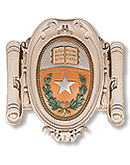
NEW ASPECTS OF CALIXPYRROLE CHEMISTRY
JONATHAN L. SESSLER, PHILIP A. GALE, VLADIMÍR KRÁL, VINCENT LYNCH, JOHN W. GENGE, WILLIAM E. ALLEN, CHRISTOPHER T. BROWN, ANDREAS GEBAUER, NICOLAI A. TVERMOES AND PETRA I. SANSOM.
DEPARTMENT OF CHEMISTRY AND BIOCHEMISTRY,
UNIVERSITY OF TEXAS AT AUSTIN, AUSTIN, TEXAS, 78712-1167, USA.

Calix[4]pyrroles have recently been shown by us to be effective and selective anion binding agents (via multiple hydrogen bonds) in both the solid and solution states.1 Additionally, these macrocycles have been shown to complex neutral species.2 The introduction of carboxylate groups to the meso-position allows the calixpyrrole to self-assemble into a dimeric structure (Fig. 1).3 New strategies for the synthesis of expanded calixpyrroles using template reactions4 and the synthesis C-rim substituted calix[4]pyrroles5 will be discussed. C-rim subsitiution has been shown to have a marked effect on anion binding strength. The introduction of a single ester group on the C-rim of the calixpyrrole provides a handle from which one may attach a wide range of molecular fragments.
Figure 1. Two calixpyrrole carboxylate anions self-assemble via multiple hydrogen bonds.
REFERENCES
1. P. A. Gale, J. L. Sessler, V. Král and V. Lynch, J. Am. Chem. Soc., 1996, 118, 5140-5141.
2. W. E. Allen, P. A. Gale, C. T. Brown, V. Lynch and J. L. Sessler, J. Am. Chem. Soc., 1996, 118, 12471- 12472.
3. J. L. Sessler, A. Andrievsky, P. A. Gale and V. Lynch Angew. Chem. Int. Ed. Engl., 1996, 35, 2782-2785.
4. P. A. Gale, J. L. Sessler, V. Lynch and P. I. Sansom, Tetrahedron Lett., 1996, 37, 7881-7884.
5. P. A. Gale, J. L. Sessler W. E. Allen, N. A. Tvermoes and V. Lynch, Chem. Commun. 1997, 665-666.